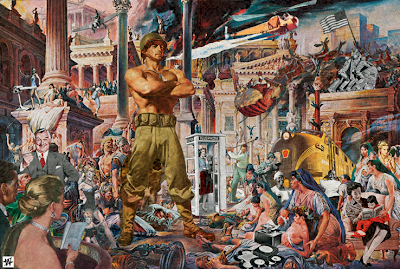Animation Samples: (find many more on youtube, vimeo, etc.)
http://www.tinkin.com/
http://www.youtube.com/watch?v=CLlJfGybBcc
http://www.youtube.com/watch?v=w7MdpwNvhkU
http://www.youtube.com/watch?v=pIPgWlE2Ybs&feature=related
Create a minimum 5-10 second long animation from one or more of your triptych images.
DUE Monday, February 6!!! Since CS3 was introduced, Photoshop now includes some rather simple yet effective animation tools similar to those available in more sophisticated animation programs such as Flash.
•FINISHED ANIMATIONS ARE TO BE EXPORTED FROM PHOTOSHOP AND UPLOADED TO YOUTUBE OR VIMEO FOR EMBEDDING INTO YOUR BLOGS! DO THIS BEFORE CLASS NEXT Monday!•
IMPORTANT SIZE INFORMATION!!!
Everybody, work at the following resolution: 1920 Height x1080 Width at 72dpi!!!
This is the standard HD 16:9 format although it is rotated for vertical formatting!
Here are some video tutorials that should help get you started.
http://www.adobe.com/designcenter/video_workshop/
From this link, go to the window on the left, scroll down and select "Photoshop CS3 Extended".
Then select in the window to the right "Animation".
Click on the video title "Animating Layers Palette" and "Using the Animation Palette" both of these are really good tutorials!
Pay particular attention to the brief tutorial using frames for animation and the timeline.
This next one is really good too! - watch the whole thing and use as a reference!
http://www.youtube.com/watch?v=7WdYqPx_SFU
Clint recommends this one! http://www.youtube.com/watch?v=Uw0sZwK7az4
These tutorials and others available online have some great information for you! They go through the process pretty fast, don't stress, watch over and over again and try the steps as described on your work.
Most important is to figure out the basics of animation using photoshop for the project. You will want to know how to place your layers in the frames, tweening, durations, movement, etc. Essentially the animation tool allows you to use your layers in an image to animate between them - it is really that simple - the complexity is in figuring out the various tools and using them effectively. Watch these tutorials as many times as it takes to figure out how to animate something. Have fun and get started immediately! If you put this off until the last minute you will not succeed in mastering these tools and creating an interesting animation!
ANIMATION WORKSHOPS WITH CLINT!!!
Laboratory Workshops will be on Tuesday at 11 and Wednesdays at 11.



